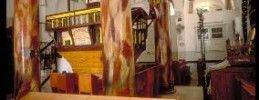Ari Sephardic Synagogue
December 22nd 2014
In Tzfat, there are two synagogues named for Rabbi Isaac Luria, more commonly known as The Ari or The AriZal. The Sephardic Synagogue of the Ari is the oldest synagogue still standing in the mystical northern city. Built more than 700 years ago, in 1301, it was originally known as the Eliyahu HaNavi (Elijah the Prophet) Synagogue.
About 300 years later, in the 16th century, just after the passing of the Ari, the synagogue was renamed to honor the time the Ari lived and prayed in Safed. During this time, the Sephardic Synagogue of the Ari was considered the most important synagogue in all of Safed.
Visitors will notice the synagogue façade’s recently restored lamps and interior blue accents that date back to the experience of the Jewish people in Moorish Spain, where the color blue was considered sacred. Built in a traditional Sephardic style, the synagogue has two not-to-miss elements: the raised, central bimah and the three Holy Arks on the southern wall, facing Jerusalem. There are six steps leading to the bimah, reflecting the mystical practice of reproducing the journey through the Six Days of Creation and into Shabbat.
Traditional local lore has it that the Ari sat on a stone-lined area in an alcove of the synagogue and communed with the biblical Elijah the Prophet, from whom he learned the deepest and most mystical Jewish teachings. While you’re visiting the synagogue, you’ll also learn how, during the War of Independence in 1948, the Israel Defense Forces removed the Torah scrolls from the building, cut firing slits into the southern wall and defended the city of Safed and its Jewish residents.
Nowadays, during the week, in a side room, a rabbi and his small group of students sit with their ancient, holy books, discussing complexities of the Torah. Prayer services are conducted only in the mornings of Shabbat and Jewish holidays and are attended by a number of the oldest families in Safed.
While you’re in Safed, it’s worthwhile to also visit the old cemetery of Safed where the Ari is buried, along with a number of other important Jewish mystics who lived in the holy city during the 16th century.












